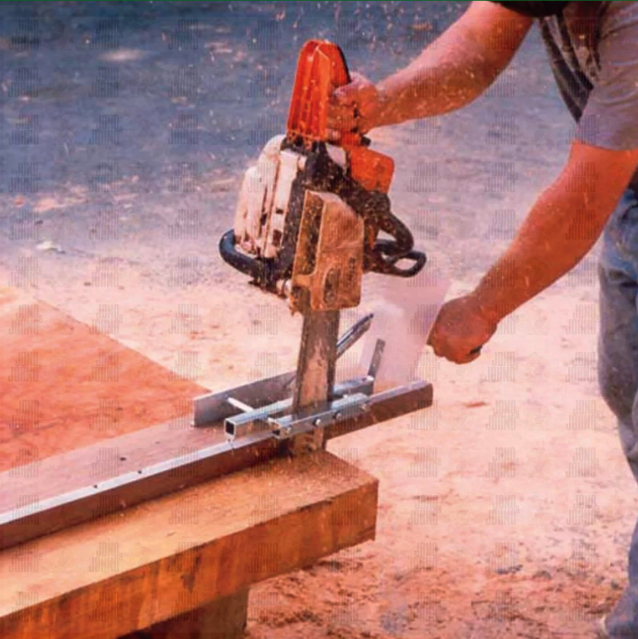A chainsaw is a powerful and potentially dangerous tool that requires proper maintenance to function safely and efficiently. If not well cared for, it can lead to serious accidents. Even something as simple as the chainsaw sputtering at an inopportune moment can cause you to lose control of your cut, leading to potential injuries or damage. If your chainsaw isn’t cutting straight, it could be due to several factors. A chainsaw sharpener might be needed, or you may need to replace the cutting teeth entirely. Here’s what you should do if your chainsaw is cutting crooked or unevenly. There are several reasons why a chainsaw might not cut straight. These issues could be related to the condition of the chain, the tension, or even how the tool is being used. Some common causes include a dull chain, uneven top plates, or damaged cutting teeth. The chain is the main cutting component of a chainsaw, so it must be properly sharpened and maintained. A dull or uneven chain can cause the saw to veer off course while cutting. This can happen because some teeth are sharper than others, making the cut inconsistent. Using high-quality chains, like those from Stihl, can help reduce the frequency of sharpening and improve performance over time. Chain tension plays a crucial role in how the saw performs. If the chain is too tight, it can wear out faster and cause unnecessary strain on the motor. If it's too loose, it can come off the bar, which is a major safety hazard. Adjusting the tension is a quick process that involves tightening or loosening the tensioning screw on the guide bar. The top plate is the flat surface on each cutter tooth. If these are uneven, the chain will not cut evenly across the wood. It’s important to check them regularly and ensure they’re all aligned correctly. The bar is the long metal part that guides the chain. Over time, it can become worn or damaged, affecting the chain's movement and causing the saw to cut crookedly. Inspecting the bar for cracks or grooves is essential for maintaining optimal performance. Even if your chain is properly sharpened, some teeth may have been damaged from hitting hard objects like stones or dirt. This can cause the saw to cut unevenly, so it's important to inspect the teeth regularly and replace them if necessary. The depth gauge controls how deep the chain cuts into the wood. If it's set incorrectly, the saw may cut too deeply or too shallow, resulting in an uneven cut. Adjusting this gauge is an important step when sharpening the chain. If your chainsaw is cutting unevenly, it might be time to sharpen the chain. Here are some steps to follow if you want to sharpen your chainsaw effectively. Before you start sharpening, make sure the chain is clean. Any dirt, grease, or debris can interfere with the sharpening process and affect the final result. Soak the chain in a mixture of water and ammonia to remove any grime, then rinse and dry it thoroughly before proceeding. Proper chain tension is essential for safe and effective operation. The chain should be slightly loose but not so loose that it slips off the bar. Adjust the tension using the tensioning screw on the side of the chainsaw. Start by sharpening the shortest cutter on the chain. This ensures that all teeth are of equal length, which is essential for a straight cut. Once you’ve done this, move on to the other teeth. Make sure to mark the first one you sharpen so you don’t lose track during the process. Hold the file at the same angle as the original notch on the cutter. This helps maintain consistent performance. File each tooth carefully, repeating the motion five to six times for each one. After sharpening one side of the chain, flip the saw and file the remaining teeth. Make sure to keep the file within the groove of the blade and not on the outside edge. This helps maintain even cutting performance. Finally, check the depth gauges to ensure they are not protruding beyond the cutting teeth. If they are, file them down slightly to prevent the chain from cutting too deeply and causing uneven results. A chainsaw that cuts in a zigzag pattern is not only inefficient but also dangerous. Using a chainsaw sharpener is one of the best ways to ensure it cuts straight and true. Remember to maintain other parts of your equipment as well for optimal performance. Jono & Johno is your go-to source for all your chainsaw needs. We offer a wide range of power tools, chains, safety gear, and more. Explore our inventory online and reach out with any questions you may have. Aluminum profiles are becoming increasingly popular in manufacturing of doors and windows. These profiles offer many advantages over traditional wood and steel frames, including superior strength, better insulation, and a longer lifespan. They are also more aesthetically pleasing, as they come in a wide range of colors and styles.We can customize according to your requirements. Aluminium Extrusion,Aluminum Profile,Aluminum Extrusion Profiles,Custom Aluminum Extrusions Foshan Knilex Aluminum Co., Ltd. , http://www.aluprofilefactory.com
Common Causes of a Crooked Chainsaw Cut
Dull or Uneven Chain
Incorrect Chain Tension
Uneven Top Plates
Worn-Out Chainsaw Bar
Damaged Cutting Teeth
Improper Depth Gauge
How to Sharpen a Chainsaw Chain Like a Pro
Step 1: Clean the Chain
Step 2: Adjust the Chain Tension
Step 3: Sharpen the Shortest Cutter First
Step 4: Use the Correct Angle
Step 5: File the Opposite Side
Step 6: Check the Depth Gauges
Find Quality Chainsaw Sharpeners at Jono & Johno